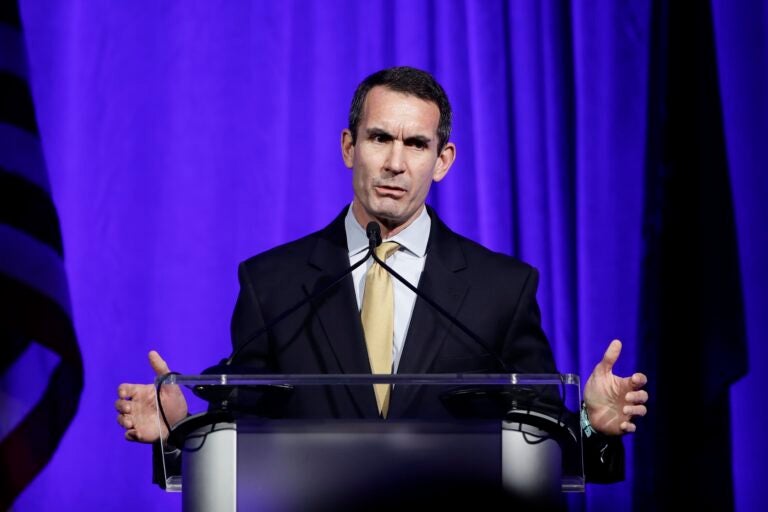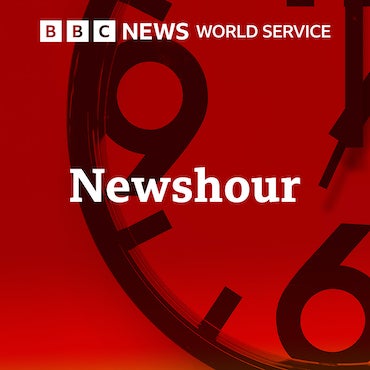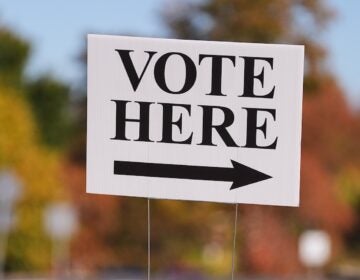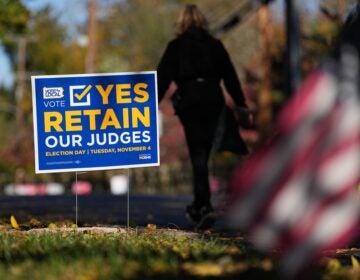‘Democratic energy’, and anger at Trump, powered wins up and down Pa. ballot, observers say
In the final days of the campaign, President Donald Trump and Barack Obama weighed in on the Pennsylvania race, which drew national attention and spending.

FILE - Pennsylvania Auditor General Eugene DePasquale speaks during a Pennsylvania Democratic Party fundraiser in Philadelphia, Nov. 1, 2019. (AP Photo/Matt Rourke, File)
This story originally appeared on WESA.
Pennsylvania Democrats are celebrating statewide judicial wins this week — a salve after a disastrous presidential election year, and reason for the party to hope for better results in the gubernatorial and Congressional midterm races of 2026.
On Tuesday, voters retained three state Supreme Court justices, who originally ran as Democrats, for additional terms on the bench, and two Democrats won vacant seats on statewide intermediate appellate courts. Even voters in bellwether Erie County decided that the incumbent county executive, a Republican, should be replaced.
Democrats and Republicans sifting through the results both agreed that the retention fight, which featured multi million-dollar spending on both sides of the retention debate, was a driving factor.
Democrats have long argued that Republicans set the tone for that debate, transforming a typically overlooked ballot question into a partisan fight. And they say that Republican-aligned billionaires sought to dominate the discussion.
“ They decided to make this a partisan affair, even though it had never been a partisan affair in the history of Pennsylvania,” said state Democratic Party chair Eugene DePasquale. “We used that as a rallying cry to say, ‘Do you want a MAGA billionaire owning the courts, or do you want the people of Pennsylvania to own the courts?’”
Commonwealth Partners, a political action committee largely funded by Pennsylvania’s wealthiest person, Jeff Yass, poured millions into the effort. But Democratic allies, including trial lawyers and unions, still gave millions more for their own pro-retention campaign, said Chris Nicholas, a veteran Republican political consultant and author of the PA Political Digest newsletter.
“On the ‘vote yes’ side, the Democrats and their allies spent four times as much money as Republicans in the ‘vote no’ [campaign],” Nicholas said. “Democrats have always cared more about judicial races here. That spending advantage allowed them to control the narrative better.”
And in the final days of the campaign, both President Donald Trump and Barack Obama weighed in on the Pennsylvania race, which drew national attention and spending. A campaign spokesperson for Gov. Josh Shapiro, who’s running for reelection next year, said the governor himself “raised a significant portion of the [Supreme Court retention] warchest” and campaigned heavily for the justices as he “recognized this as one of the most important races across the country in 2025.”
Due to all that attention and spending, higher-than-usual election turnout across the state — and about 45% of registered voters in Allegheny County — makes sense to political pollster Berwood Yost, who directs Franklin & Marshall College’s Center for Opinion Research.
“The attention paid to the retention election — that is part of what drove up turnout,” Yost said. “Let’s face it, if you’re in many localities in Pennsylvania, there isn’t much competition, right? I mean, a Democrat’s gonna win Philly or win Pittsburgh.”
But compared to the presidential election, “the average change was 15% towards the Democrats,” Yost said. “[Justice] Christine Donohue performed about 15 points better on average in every county than Kamala Harris did.”
Philadelphia, a Democratic stronghold but one whose turnout has sometimes disappointed the party, had a turnout 8% higher than the 2023 election, said Chris Borick, a political science professor and director of Muhlenberg College Institute of Public Opinion. That “Democratic energy” may have come from mailers and pro-retention campaigns, but also likely came from voters dissatisfied with the Trump administration, he said.
It was not your usual “low-engagement, low-turnout, low-knowledge elections, where voters largely don’t see many ads,” Borick said.
Democratic leaders hope results in more rural Southwestern Pennsylvania counties, such as Beaver, Washington and Westmoreland point to progress made by the party after a dismal turnout in last year’s presidential and statewide row office races. Those three counties overwhelmingly voted for Donald Trump — by up to a 28-point margin in Westmoreland — but on Tuesday over half of their voters said “yes” to return Democratic justices to the state Supreme Court.
“We made a point — from the candidates and myself and the party — to go everywhere,” said state party chair DePasquale, adding he alone visited 20 counties in the final two-and-a-half months before Tuesday. “The county chairs we have [in Washington and Westmoreland] are great partners with me on getting organizers, getting volunteers … so it was a team effort.”
Democrats caution that the party cannot afford to get complacent despite its wins this week. “The anti-vote will take you [only] so far,” said Allegheny County Democratic Committee Chair Sam Hens-Greco. “The biggest thing is we’ve got to tell people who we are and where we are going.”
Democrats have spent the past year coming to grips with polling and other evidence that many voters either don’t know its priorities, or don’t feel that they are included among them. Hens-Greco says addressing those doubts requires “building that grassroots network. It’s hard work … but it pays dividends, and I think you see that in Allegheny County.”
Indeed, local Republicans suffered a number of setbacks Tuesday, including the loss of a county council seat long held by the party.
“In Allegheny County, they had 460-some elections for local municipal office,” Nicholas said. “Republicans only beat Democrats in 11 of them.”
“Sometimes you’re the windshield,” he added, “and sometimes you’re the bug.”
Chris Potter contributed reporting.
WHYY is your source for fact-based, in-depth journalism and information. As a nonprofit organization, we rely on financial support from readers like you. Please give today.





